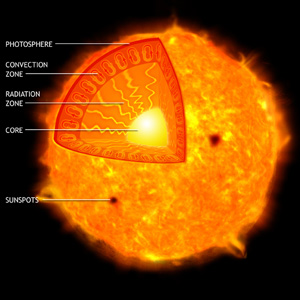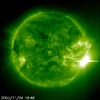Normal stars such as the Sun are hot balls of gas millions of kilometers in diameter. The visible surfaces of stars are called the photospheres, and have temperatures ranging from a few thousand to a few tens of thousand degrees Celsius. The outermost layer of a star's atmosphere is called the "corona", which means "crown". The gas in the coronas of stars has been heated to temperatures of millions of degrees Celsius.
Most radiation emitted by stellar coronas is in X-rays because of its high temperature. Studies of X-ray emission from the Sun and other stars are therefore primarily studies of the coronas of these stars. Although the X-radiation from the coronas accounts for only a fraction of a percent of the total energy radiated by the stars, stellar coronas provide us with a cosmic laboratory for investigating how hot gases are produced in nature and how magnetic fields interact with hot gases to produce flares, spectacular explosions that release as much energy as a million hydrogen bombs.
The heating of a star's corona and the flare phenomenon are related to the important question of how energy is transported from the nuclear furnace in the star's central regions to the surface.
In hot massive stars, the energy flowing out from the center of the star is so intense that the outer layers are literally being blown away. Unlike a nova, these stars do not shed their outer layers explosively, but in a strong, steady stellar wind. Shock waves in this wind produce X-rays; from the intensity and distribution with energy of these X-rays, astronomers can estimate the temperature, velocity and density of this wind.
See effects of wind on environment in Young Stars and Star Clusters.
In medium-sized stars, such as the Sun, the outer layers consist of a rolling, boiling turmoil called convection. A familiar example of convection is a sea-breeze. The Sun warms the land more quickly than the water and the warm air rises and cools as it expands. It then sinks and pushes the cool air off the ocean inland to replace the air that has risen, producing a sea-breeze. In the same way, hot gas rises from the subsurface layers that extend to a depth of about 200,000 kilometers, cools at the surface and descends again.
The intense heat in the atmosphere of stars like the Sun frees some of the electrons from their atoms. Because of this, the magnetic fields are dragged along with the rising and falling gas. An additional complication is that the star is rotating. The up-and-down motion, coupled with the round and round motion of rotation, twists the magnetic field and increases its strength. Twisted, magnetized tubes of gas rise high above the surface of the star. There they unwind, releasing stored energy. (Try twisting and untwisting a rubber band and you get an idea of this process.)
The release of magnetic energy can occur steadily and provide for the heating of the tubes of hot gas which make up the stellar corona. Or it can occur violently and produce flares. Flares can occur on the Sun at any time, but their frequency tends to rise from a peak of five to ten a day and fall to less than one per day in a cycle of about eleven years. Solar flares can shower the Earth in high-energy particles. A strong one can disrupt radio communications and produce spectacular displays known as the Northern and Southern Lights. Flares may even have a subtle but important effect on our weather.
This picture is a false-color image of the X-28 flare on November 4, 2003 taken with SOHO's Extreme ultraviolet Imaging Telescope (EIT). X-class flares are most powerful category, capable of releasing the energy of a billion one-megaton nuclear bombs. The flare is the white area near the bottom right of the image (the horizontal lines resulted when the flare's intense light saturated the EIT instrument). The flare came from Active Region 10486, and is the largest flare ever recorded in X-rays.
If solar flares were more powerful or frequent the climate could be severely affected, as would the ozone layer which protects us from the harmful effects of ultraviolet radiation. Life as we know it could become difficult if not impossible. Presently there is not enough evidence to determine if such changes are likely. X-ray observations of a large number of stars similar to the Sun are essential for understanding the long term behavior of the Sun, and consequently, the long-term weather forecast for Earth.
Certain stars, called flare stars, have surfaces that are in a constant state of turmoil. These stars, which typically have masses half or less than that of the sun, flare almost continually and the flares are a hundred or more times more powerful than solar flares. Because of their small masses, their interiors are much more turbulent and they are rotating more rapidly. This combination of turbulence and rotation produces large, severely twisted magnetic regions, which lead to large flares.
Feel like a star expert? Try our Star Search word search!





